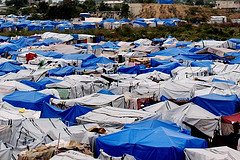IRIN does a very good job untangling the complicated bureaucratic impediments to the United States disbursing promised money for Haiti reconstruction. The short story is this: at a donors conference in March, the United States pledged $1.4 billion for long term reconstruction in Haiti. So far, none of that money has actually reached Haiti.
The Obama administration had asked congress for a total of $2.8 billion for Haiti assistance, but the final version of the legislation (H.R. 4899, P.L. 111-212) included a total of $2.93 billion for Haiti. The money was divided into three categories: $1.642 billion was earmarked for relief; $1.140 billion for recovery and reconstruction (the money Clinton promised); and $147 million for diplomatic operations, according to a Congressional Research Service report on 6 August 2010.
As of September, the US Agency for International Development (USAID) reported that more than $1.1 billion of the $1.642 billion for Haiti relief had been spent since the earthquake. But the $1.140 billion for recovery and reconstruction has remained in the US treasury because the vast proportion of this assistance cannot be disbursed until the secretary of state reports to various congressional committees on exactly how the money will be spent and how its oversight will be managed.
In the meantime, conditions are miserable enough in Haiti’s makeshift IDP camps that a cholera outbreak is able to kill more than 50 people. I think Walter Kaelin, Representative of the Secretary-General on the Human Rights of Internally Displaced Persons, said it well yesterday when he described the situation as “a humanitarian crisis the needs a development solution.”
“This is a humanitarian crisis that needs a development solution. In line with its primary responsibility, the Government of Haiti needs to endorse and communicate publicly a plan on how to provide durable solutions for those in the camps and to inform and consult with the displaced on its implementation.
“In the meanwhile, if development donors ensure flexible, early recovery orientated funding arrangements, smaller-scale neighbourhood reconstruction can get underway and provide much needed hope,” noted Kaelin while urging humanitarian donors to continue funding humanitarian assistance and protection activities as long as no substantial progress towards durable solutions is made.
